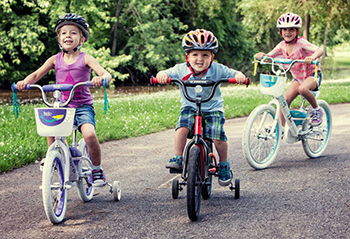
Bicycle Safety: Myths and Facts by Colleen Kraft, M.D.
 Learning to ride a bike is a developmental milestone in the life of a child. The bicycle, a child’s first vehicle, is a source of pride and a symbol of independence and freedom. Yet all too often children are seriously injured, or even killed, when they fail to follow basic bicycle safety rules. The following is a list of common bicycle safety myths, coupled with the correct information you need to teach your children about safe bike riding. These facts will help you and your children make every bike ride safe.
Learning to ride a bike is a developmental milestone in the life of a child. The bicycle, a child’s first vehicle, is a source of pride and a symbol of independence and freedom. Yet all too often children are seriously injured, or even killed, when they fail to follow basic bicycle safety rules. The following is a list of common bicycle safety myths, coupled with the correct information you need to teach your children about safe bike riding. These facts will help you and your children make every bike ride safe.
Myth: My child doesn’t need to wear a helmet on short rides around the neighborhood.
Fact: Your child needs to wear a helmet on every bike ride, no matter how short or how close to home. Many accidents happen in driveways, on sidewalks, and on bike paths, not just on streets. In fact, the majority of bike crashes happen near home. A helmet protects your child from serious injury, and should always be worn. And remember, wearing a helmet at all times helps children develop the helmet habit.
Myth: A football helmet will work just as well as a bicycle helmet.
 Fact: Only a bicycle helmet is made specifically to protect the head from any fall that may occur while biking. Other helmets or hard hats are made to protect the head from other types of injury. Never allow your child to wear another type of helmet when riding a bike.
Fact: Only a bicycle helmet is made specifically to protect the head from any fall that may occur while biking. Other helmets or hard hats are made to protect the head from other types of injury. Never allow your child to wear another type of helmet when riding a bike.
Myth: I need to buy a bicycle for my child to grow into.
Fact: Oversized bikes are especially dangerous. Your child does not have the skills and coordination needed to handle a bigger bike and may lose control. Your child should be able to sit on the seat, with hands on the handlebars, and place the balls of both feet on the ground. Your child’s first bike should also be equipped with foot brakes, since your children’s hand muscles and coordination are not mature enough to control hand brakes.
Myth: It’s safer for my child to ride facing traffic.
Fact: Your child should always ride on the right, with traffic. Riding against traffic confuses or surprises drivers. Almost one fourth of bicycle-car collisions result from bicyclists riding against traffic.
Myth: Bike reflectors and a reflective vest will make it safe for my child to ride at night.
Fact: It’s never safe for your child to ride a bike at night. Night riding requires special skills and special equipment. Few youngsters are equipped with either. Never allow your child to ride at dusk or after dark.
Myth: I don’t need to teach my child all of this bicycle safety stuff. I was never injured as a child. Biking is just meant to be fun.
Fact: Riding a bike is fun – if it’s done safely. Unfortunately, most people don’t realize hundreds of thousands of children are seriously injured each year in bicycle falls. Worse still, more than 600 children die from them each year. While you may have been lucky enough to survive childhood without a serious bicycle-related injury, you shouldn’t count on luck to protect your child.
Source: HealthyChildren.org
The information provided is for general interest only and should not be misconstrued as a diagnosis, prognosis or treatment recommendation. This information does not in any way constitute the practice of medicine, or any other health care profession. Readers are directed to consult their health care provider regarding their specific health situation. Marque Medical is not liable for any action taken by a reader based upon this information.
